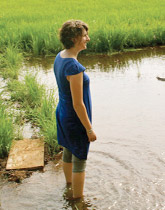I had to get out of the heat and humidity. Although it was only March, temperatures were routinely exceeding 100 degrees in Pondicherry, India. Not exactly the kind of weather my classmates at Carnegie Mellon faced back in Pittsburgh. Although I had lived through my share of oppressive weather growing up in suburban Baltimore, at least there seemed to be air conditioning everywhere. That’s not the case in southern India. I had no regrets being there, studying Spoken Tamil, The Idea of India in Literature, Christianity in India, and 19th-Century British Fiction, but it was time for me to take a break from the heat.
I convinced four of my study-abroad classmates to go with me to Kodaikanal, located in the Western Ghats of Tamil Nadu. I’d heard it was a breathtaking city with a landscape vastly different from the flatlands of Pondicherry. The drawback was the 10-hour bus ride to get there, but evidently my friends were as sick of the heat as I was. When they agreed to go, I hurriedly purchased five bus tickets before they had the chance to change their minds.

We would board the bus the next day. But there was one problem: I could only buy tickets to travel to Trichy, just halfway to Kodaikanal, with a 2 am arrival time. “Don’t worry,” I told everyone, “we’ll just go from there. It’ll be fine.” My traveling companions were skeptical, and in reality so was I. Maybe it was the thrill of an open-ended destination—we all decided to go ahead with the trip anyway.
When we arrived in Trichy, in the middle of the night, we were bleary-eyed and clueless about what to do next. We looked around and saw men urinating in the street, stray dogs roaming about, and families sleeping on the pavement. In much of southern India, there is heartbreaking poverty, and though we had become somewhat accustomed to it after a few months, my travel companions and I knew that Trichy at 2 am wasn’t somewhere we wanted to find lodging. As we ambled across the road, a man came up to us:
“Kodaikanal? Kodaikanal?” he yelled, gesturing toward a large tour bus.
We looked at each other, immediately suspicious that this guy knew exactly where we wanted to go and seemingly had a way to get us there.
“Kodaikanal?” we responded in unison.
“Yes, yes, Kodaikanal!” he replied, trying to hurry us along.
“How much?” I asked.
“250 rupees.”
As we looked toward the dimly lit city, with trash blowing in the breeze, and the beggars shuffling toward us, it was an easy decision. We climbed onto the bus. By daybreak, we were high in the beautiful hills of Kodaikanal. Certainly, the itinerary had been less-than-ideal; but, for me, my semester in India was supposed to be about the journey, not just the destination. In this case, my experience was about both—the difficulty of the bus ride, followed by the breezy reward of finally reaching Kodaikanal. I had to leave the classroom to learn this lesson, to immerse myself in the culture: the good, the bad, and the fluidity of India.
—Caroline Kessler (HS’12)



